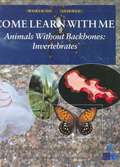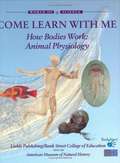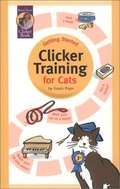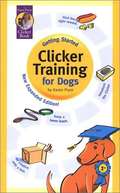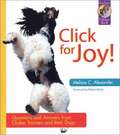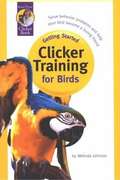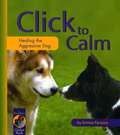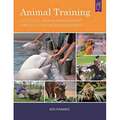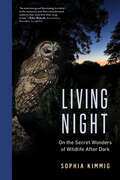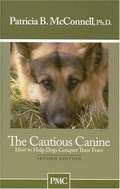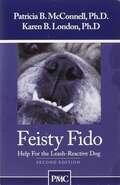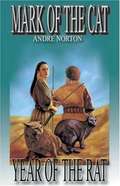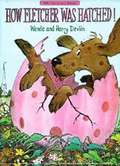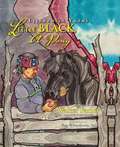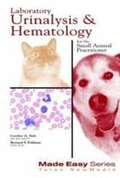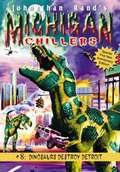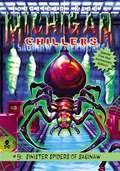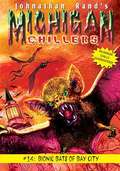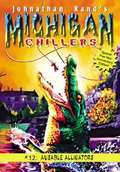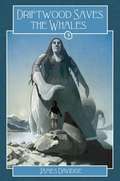- Table View
- List View
The Jazz Fly
by Matthew GollubA singular story about musical insects celebrating language and the inventive spirit of jazz.
Keeper Of The Swamp
by Ann GarrettAboy and his ailing grandfather pole a small boat out into the Louisiana bayou. Suddenly, they spot Boots, a female alligator the grandfather saved from poachers years ago. <P><P>How will the boy face the danger in learning to take care of this wild creature? Strikingly illustrated with artwork that combines oil painting and computer imaging, Keeper of the Swamp is a scary and satisfying tale that carries a strong environmental message.
Animals Without Backbones: Invertebrates
by Bridget AndersonIf you are asked to picture an animal, what comes to your mind first? A dog? A bird? Perhaps a zebra? Chances are you thought of a vertebrate, an animal with a backbone. But vertebrates, which include the animals we are most familiar with--mammals, birds, fish, reptiles, and amphibians--actually make up less than 5% of all animal species. All the rest of the animals alive today--more than 95%--are invertebrates, animals without backbones. Can you picture a spotted ladybug, spiny sea urchin, or slimy garden slug? ANIMALS WITHOUT BACKBONES: INVERTEBRATES explores the lives of the many fascinating creatures.
How Bodies Work: Animal Physiology
by Bridget AndersonDo you ever wonder what makes you grow? Or why you shiver when you are cold? Have you ever marveled at the speed of a cheetah, the fastest land animal on Earth? Or been awed at how a chameleon can change color? Solving such mysteries is part and parcel of animal physiology, the science that investigates how different animal bodies work. Learning how they do increases our appreciation of the uniqueness and diversity of the vast animal kingdom, and adds to our understanding of how our own bodies work. HOW BODIES WORK: ANIMAL PHYSIOLOGY offers a glimpse inside ourselves and the amazing world around us.
Getting Started: Clicker Training for Cats
by Karen PryorFrom the Book jacket: you can! Clicker training, the new way of communicating with animals, is quick and easy for you - and it's fun for your cat. Clicker training can improve your cat's health, activity, and attitude toward life. It can make your cat happier and more affectionate. In this easy-to-read beginner's guide, Karen Pryor, the world's leading clicker training expert, tells you how to teach your cat: to come when called to play without biting or scratching to stay off the table to get along with dogs to walk outside on a leash to do cute tricks and games! All with a click and a treat!
Getting Started: Clicker Training for Dogs (Revised Edition)
by Karen Pryor"Clicker Training-easy for you, fun for your dog! "Turn your pet into a great dog with easy, all-positive clicker training. Clicker expert Karen Pryor shows you how to use clicks and treats to teach your dog: Good manners, including walking without pulling and sitting to greet Housetraining and obedience Games and tricks "If your dog has been labeled untrainable, if he has been call soft, aggressive, dominant, hard-headed, stubborn, or independent-In short, if you have a DOG-clicker training is the solution you've been searching for." - Melissa Alexander trainer and owner of www.clickersolutions.com; author, Clicker Solutions: The Clicker Training Answer Book "Clicker training is sweeping the nation. It's fun, fast, and positive. A 2-tail salute to Karen Pryor, a trainer who brought clickers to the dog world... " - Sarah Hodgson trainer and author, Dog Tricks for Dummies "With clicker training, a dog begins to understand that his actions influence his environment. With this understanding comes trust and respect for the owner. " - Emma Parsons trainer/behaviorist, Yankee Golden Retriever Rescue; author, Click to Calm: Training to Heal the Aggressive Dog "Karen Pryor's clicker training is the most compelling demonstration of dog training that I have ever seen. No dog should go without this information. " - Dr. Nicholas Dodman, Director, Behavior Clinic Tufts University School of Veterinary Medicine."
Click for Joy! Questions and Answers from Clicker Trainers and their Dogs
by Melissa C. AlexanderThis is a marvelous resource for those who are curious about training a dog to the clicker. The step-by-step instructions make it a usefull tool for those who are involved in such training. Alexander explains how to work on specific behaviors such as fearfulness and always emphasizes the fun and positiveness which should accompany training any dog no matter how tough its challenge.
Getting Started: Clicker Training for Birds
by Melinda JohnsonLooking for a new way to have fun playing with your bird buddy? Or is his nickname "Birdzilla" and you have the scars to prove it? Maybe your bird is a depressed little perch potato that refuses to play at all? This new way of training birds with a clicker and treats can dramatically change your bird's behavior and improve your life together.
Click to Calm: Healing the Aggressive Dog
by Emma ParsonsPositive Answers for the Aggressive Dog. The dog that bites. The dog that attacks other dogs. The dog who may not survive his own aggressive behavior. What can be done to help these dogs? When Emma Parsons, canine behavior consultant, discovered that her own dog was aggressive, she developed innovative and effective strategies to calm, alter, and re-shape his reactive displays, and those of her clients' dogs.
Animal Training: Successful Animal Management Through Positive Reinforcement
by Ken RamirezA trainer and consultant for nearly 40 years, Ken Ramirez is well regarded as a leader in the animal training world. In his bestselling book Animal Successful Animal Management Through Positive Reinforcement, Ken has selected and organized almost 600 pages of what in his opinion are the best papers, articles, and presentations on the topic of reinforcement-based training, each making a special point, each worth some serious attention. Here’s a chance to really explore the thinking and the training protocols involved in reinforcement-based training—whether it’s your dog or a cranky elephant or a group of killer whales. Contributors include the Baileys, many ClickerExpo faculty members, scientists and graduate students, dog trainers, dolphin trainers, zoo behaviorists, and Ken Ramirez himself. Karen Pryor’s work and references to Don’t Shoot the Dog appear throughout. This is a year or more of entertaining bedside reading for any training buff, and an important resource for the serious student of operant conditioning. Many of the reprinted articles include data, graphs, training logs, and other background material, and detailed references. A trainer and consultant for nearly 40 years, Ken Ramirez is well regarded as a leader in the animal training world. In his bestselling book Animal Successful Animal Management Through Positive Reinforcement, Ken has selected and organized almost 600 pages of what in his opinion are the best papers, articles, and presentations on the topic of reinforcement-based training, each making a special point, each worth some serious attention. Here’s a chance to really explore the thinking and the training protocols involved in reinforcement-based training—whether it’s your dog or a cranky elephant or a group of killer whales. Contributors include the Baileys, many ClickerExpo faculty members, scientists and graduate students, dog trainers, dolphin trainers, zoo behaviorists, and Ken Ramirez himself. Karen Pryor’s work and references to Don’t Shoot the Dog appear throughout. This is a year or more of entertaining bedside reading for any training buff, and an important resource for the serious student of operant conditioning. Many of the reprinted articles include data, graphs, training logs, and other background material, and detailed references.
Living Night: On the Secret Wonders of Wildlife After Dark
by Sophia KimmigNatural darkness isn’t merely a time of day. For countless extraordinary species, it’s home. “An entertaining and illuminating love letter to the mysterious and often misunderstood creatures that come alive when we go to bed—and a call to preserve our precious, shared world.”—Robin Bicknell, award-winning documentary filmmaker, Ice and Fire and Nature’s Cleanup Crew When the sun sets, things start to get interesting among wild animals. Wherever we live, whether in the city or suburbs or country, darkness conjures a hidden world of wildlife that most of us rarely glimpse. Foxes, wolves, and bears prowl while skunks, opossums, and porcupines lurk; fireflies send flashing signals to potential mates; raccoons rummage for food; owls and bats fly overhead. Wildlife biologist Sophia Kimmig is our guide to the startling behaviors of these and many more nocturnal creatures. Introducing us to night’s wild inhabitants, she reveals what life for them is like in this parallel world—how it looks, feels, and smells—and the ingenious ways some creatures thrive after sunset. Living Nighthelps us appreciate how essential darkness is: not just a time but a diverse habitat all to itself—one that we still know too little about, and that we must urgently protect for the benefit of the world’s flora and fauna that depend on the day–night cycle.
The Cautious Canine: How to Help Dogs Conquer Their Fears (Second Edition)
by Patricia B. McconnellIn a calm and patient manner, Dr. McConnell lays out a step-by-step program for helping dogs overcome their fears. Although this is a detailed training manual, it is both easy to read and easy to use. McConnell is a wel-known, highly-credentialed behaviorist who has specialized in helping family pets to become well-adjusted and happy canines. Gentle and sensible methods are presented here. Also available from Bookshare: "The Other End of the Leash."
I'll be Home Soon!: How to Prevent and Treat Separation Anxiety (How-To Booklets From Dogs Best Friend Series)
by Patricia B. McConnellFigure out if your dog suffers from genuine separation anxiety or just bad manners. Then learn how to keep her happy and your home safe while our are gone. Better yet, learn to prevent problems in the first place!
Feisty Fido: Help for the Leash-Reactive Dog
by Patricia B McConnell Karen B LondonA dog who barks and lunges at other dogs when out for a walk is embarrassing and potentially dangerous. Using these pet-friendly, positive reinforcement techniques you'll soon be able to relax and enjoy your walks.
Mark Of The Cat: Year Of The Rat
by Andre NortonA boy sets off on a quest to find the relatives of his cat familiar, who has been killed. Facing danger and mystery at every turn, he is forced to grow up as he seeks a secret society of cats.
How Fletcher Was Hatched
by Wende Devlin Harry DevlinFletcher is a large hound dog with brown spots, and his mistress is a little girl named Alexandra. The trouble starts because Alexandra is interested in baby chicks - tiny, fluffy, yellow chicks that say "Peep!" as they come out of their shells. Fletcher's water dish is empty. He hasn't had his ears scratched in days. "She's forgotten me," he decides, and mournfully he shuffles off to the park at the edge of town. Here Fletcher's good friends, Beaver and Otter, have the idea. Fletcher must hatch! Of course, Beaver is a master builder, and it's no trouble at all to build an egg around Fletcher. The egg is large and pink and speckled with brown, and it poses somewhat of a problem for the school principal, not to mention the science teacher. But young readers will delight in the hilarious climax, along with a little girl named Alexandra. This file should make an excellent embossed braille copy.
Control Unleashed: Creating a Focused and Confident Dog
by Leslie McdevittThis book is for anybody who wants to teach her dog to focus in difficult situations. It's also especially for people whose dogs are easily distracted, stressed, or reactive.
Little Black, A Pony, First Edition
by Walter Farley<P>Theme of this book is friendship and unwavering loyalty. <P>A little boy is in love with horses. <P>He takes Little Black, his very own pony, on rides all around his family's property.<P> However, one day the boy decides to ride Big Red, a horse that can do practically everything--run fast, jump over obstacles, and even swim across rushing rivers! <P>The boy begins spending more and more time with Big Red and less and less time with Little Black.<P> However, when a ride on Big Red ends in a frightening accident, the boy must rely on Little Black to save him.
Laboratory Urinalysis and Hematology for the Small Animal Practitioner
by Carolyn Sink Bernard FeldmanThe main goal of this book is to provide an easily readable and accessible guide which we hope will be readily found on the laboratory bench and will be constantly open and used.
Dinosaurs Destroy Detroit (Michigan Chillers, #8)
by Jonathan RandRight before us, the window appeared! It opened like a nightshade, sweeping down toward the ground. It was about twenty feet wide and very high ... taller than a house! It was as if a fuzzy gray sheet had been placed in the air right in front of us. Then the grayness began to fade, giving way to a shimmering, clear window. I could see right through it! However, objects on the other side of the window--tree trunks, leaves, branches -- they seemed to sway and bend. It was like looking at something through wavering heat waves.I couldn't speak. My mouth was open, but I didn't know what to say.
Sinister Spiders of Saginaw (Michigan Chillers, #9)
by Jonathan RandMom had just left the kitchen, and I returned to my homework. I had my nose in a book, and was double-checking the answers on my math paper. We were going to have a quiz today. Ug. I felt a light tickling on my ankle, and I looked down. It was a spider! Not a big one, mind you--but that didn't matter. It was a spider, and it was crawling on me.
Bionic Bats of Bay City (Michigan Chillers #14)
by Johnathan RandMICHIGAN CHILLERS WINGED MONSTERS ATTACK AN ENTIRE CITY! On a dark night in Bay City, Michigan, friends gather to plan an innocent game of hide-and-seek. However, just as they begin to play, one of them sees a bat. But it's not any ordinary bat. In fact, the bat is gigantic--as big as some of the children! And there's more than one. Forced to abandon their game, five children must flee the vicious attacks of these giant creatures from the sky. Unable to take refuge in their homes, they must fight to survive. Where did these bats come from? How on earth did they grow to such enormous size? And most important: will the five children be able to defend themselves until help arrives, or will the bats have their way? It's a night of horror in Bay City . . . and for five friends, it just might be their last night alive! #14: Bionic Bats of Bay City by Johnathan Rand
Au Sable Alligators (Michigan Chillers #12)
by Rand JohnsonRight here, in the AuSable River, at the end of my line with a fly hooked in its mouth, was an alligator! He wasn't very big--maybe about the size of the rainbow trout I'd caught earlier--but that didn't mean the creature wasn't dangerous. I wanted to throw down my net, toss my rod into the water and run. I had to get away, out of the water. I had to get home. Mom and Dad would know what to do. But before I could even react, the alligator opened its jaws even wider. It hissed loudly...and with a powerful swish of its tail, the beast lunged right at me!
Scaredy Squirrel Prepares for Halloween: A Safety Guide for Scaredies (Scaredy Squirrel Series)
by Mélanie Watt"Halloween is creeping up quickly," warns everyone's favorite worrywart, "and it's time to gather the courage to face the ghoulish festivities!" And according to Scaredy Squirrel, the best way to do that is by being prepared. So he's compiled this essential guide full of ideas, strategies and plans to help readers survive Halloween "all in one piece!" From costume suggestions rated with Scaredy's own specially designed SCARE-O-METER (it helps gauge the fear factor), to instructions for visiting a haunted mansion (tip: don't make eye contact when passing the graveyard), to recommendations for outwitting infamous Halloween monsters (example: challenge Frankenstein to count), his advice covers every Halloween danger imaginable (plus many more you never thought of!). Of course, if all else fails, Scaredy has a surefire backup plan: play dead. Because on this, the scariest day of the year, Scaredy Squirrel's leaving nothing to chance! <P><P>Lexile Measure: AD670L
Driftwood Saves The Whales
by James DavidgeDriftwood Saves the Whales Book Three of the Driftwood Saga. Angering the Inuit sea goddess Sedna brings about powerful visions and overwhelmingabilities for the young sorceress Driftwood Ellesmere. Giants created by HansBlekansit continue to spew Blekan-Marts all over the world. Odin, Thor and otherNorse Gods return to Earth to conduct illegal whaling. A surprise reunion helpsHarry Blekansit finally get off the toilet. Amidst all the chaos Driftwood and Rosebecome celebrities caught up in a strange merchandizing deal. And to top things offDriftwood never seems to having any success talking to Tide, the boy she likes fromCamp Magee. Will our heroine ever figure out how to cope with the wild world aroundher?The Driftwood Saga chronicles the magical quests of a young girl and her attemptsto understand and solve various world problems including child labour, excessivelogging and the military industrial complex. Driftwood Saves the Whales, theexciting third volume, is written by James Davidge (Mathemagick & Mystiphysics, TheDuchess Ranch of Old John Ware) with illustrations by Eric Jordan.


